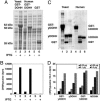Molecular cloning, expression, and structural prediction of deoxyhypusine hydroxylase: a HEAT-repeat-containing metalloenzyme
- PMID: 16371467
- PMCID: PMC1324997
- DOI: 10.1073/pnas.0509348102
Molecular cloning, expression, and structural prediction of deoxyhypusine hydroxylase: a HEAT-repeat-containing metalloenzyme
Abstract
The eukaryotic initiation factor 5A (eIF5A), a factor essential for eukaryotic cell proliferation, is the only cellular protein containing the polyamine-derived amino acid hypusine [N(epsilon)-(4-amino-2-hydroxybutyl)lysine]. Hypusine is formed in a posttranslational modification that involves two sequential enzymatic steps catalyzed by deoxyhypusine synthase and deoxyhypusine hydroxylase (DOHH). By screening a Saccharomyces cerevisiae GST-ORF library for expression of DOHH activity, we have cloned YJR070C as the gene encoding DOHH and identified the human homolog DOHH gene, HLRC1. Purified recombinant yeast and human DOHH enzymes effectively catalyzed hydroxylation of the deoxyhypusine residue in the eIF5A intermediate. Overexpression of human DOHH along with eIF5A precursor and deoxyhypusine synthase was required for overproduction of mature, hypusine-containing eIF5A in 293T and other mammalian cells. The Saccharomyces cerevisiae strain with deletion of YJR070C contained only deoxyhypusine but no hypusine, indicating that YJR070C was the single DOHH gene in this organism. One highly conserved DOHH homolog gene is found in a variety of eukaryotes from yeast to human. Sequence and structural analyses reveal that DOHH belongs to a family of HEAT-repeat-containing proteins, consisting of eight tandem repeats of an alpha-helical pair (HEAT motif) organized in a symmetrical dyad. The predicted structure is unrelated to the double-stranded beta-helix type structures of the Fe(II)- and 2-oxoacid-dependent dioxygenases, such as collagen prolyl or lysyl hydroxylases. However, metal coordination sites composed of four strictly conserved histidine-glutamate sequences were identified, suggesting that DOHH enzymes have convergently evolved an iron-dependent hydroxylation mechanism.
Figures





References
-
- Park, M. H., Lee, Y. B. & Joe, Y. A. (1997) Biol. Signals 6, 115–123. - PubMed
-
- Chen, K. Y. & Liu, A. Y. (1997) Biol. Signals 6, 105–109. - PubMed
-
- Joe, Y. A., Wolff, E. C. & Park, M. H. (1995) J. Biol. Chem. 270, 22386–22392. - PubMed
-
- Abbruzzese, A., Park, M. H. & Folk, J. E. (1986) J. Biol. Chem. 261, 3085–3089. - PubMed
Publication types
MeSH terms
Substances
Grants and funding
LinkOut - more resources
Full Text Sources
Molecular Biology Databases
Research Materials

